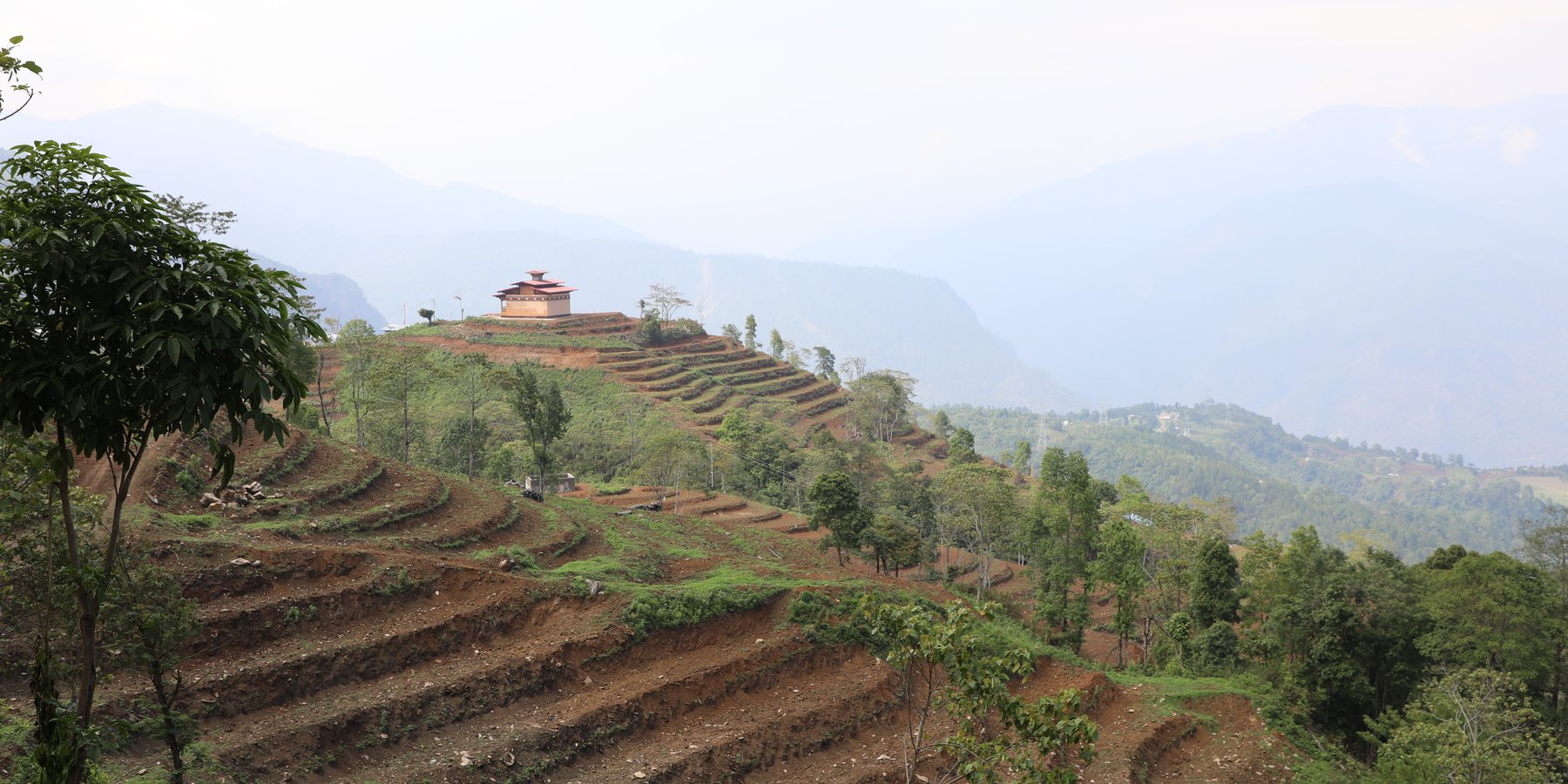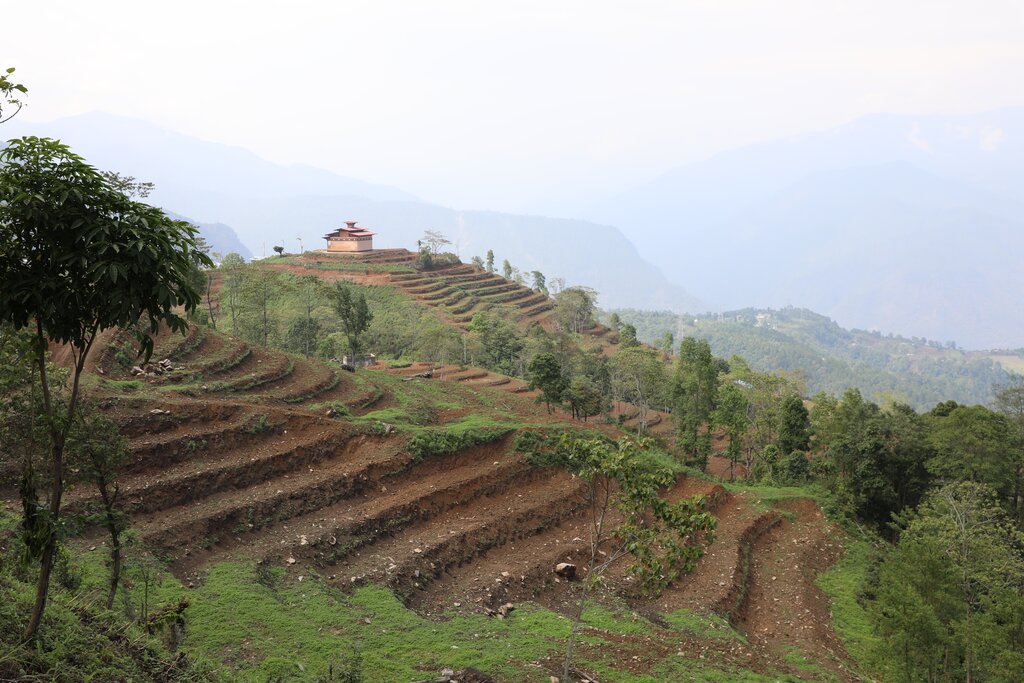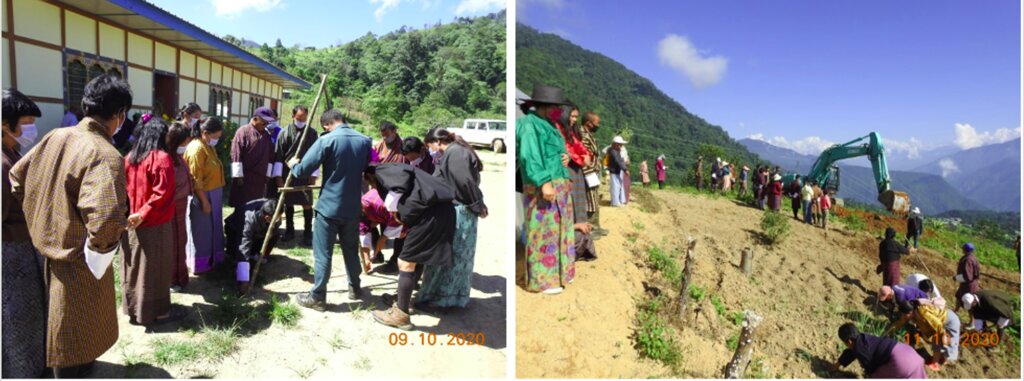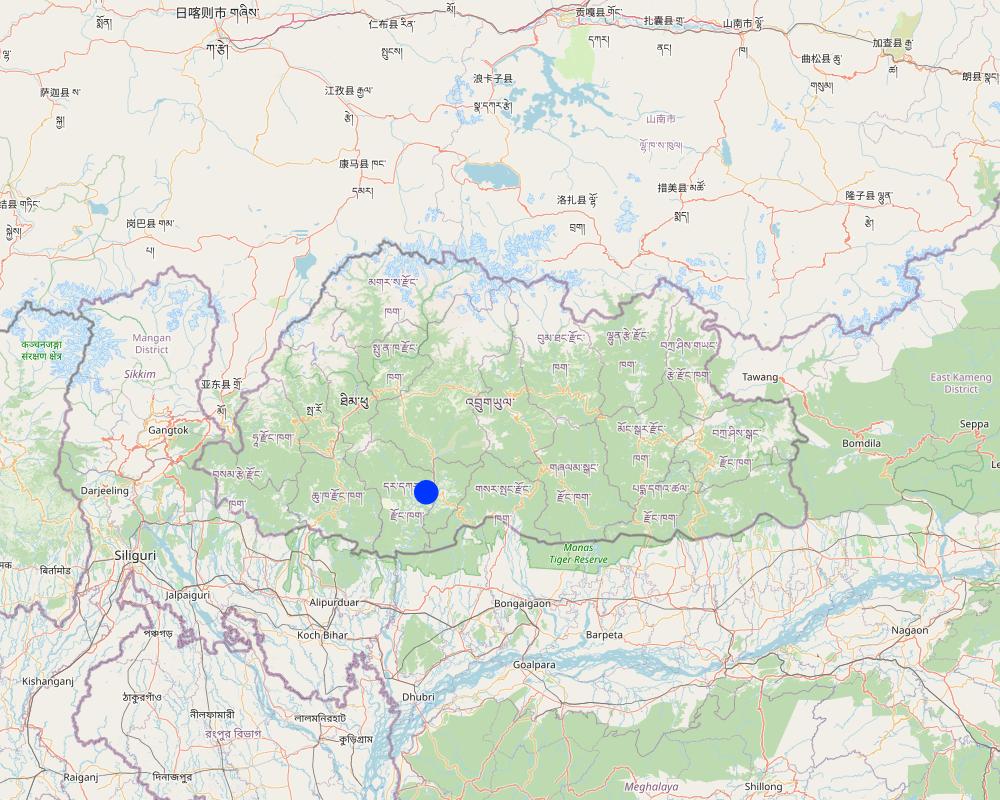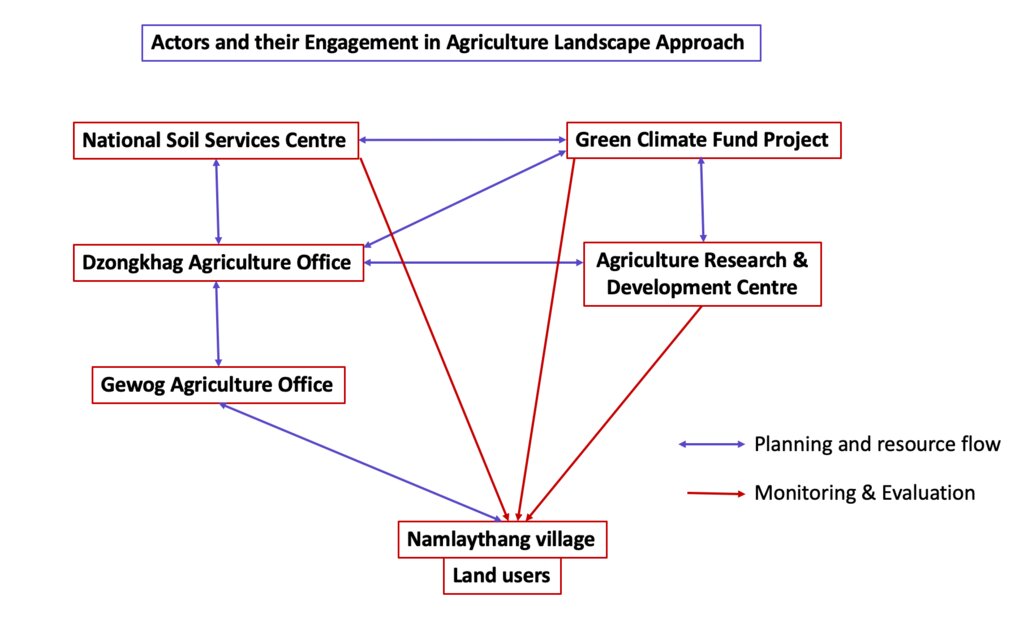Agricultural Landscape Approach for SLM Implementation [ภูฏาน]
- ผู้สร้างสรรค์:
- การอัพเดท:
- ผู้รวบรวม: Nima Dolma Tamang
- ผู้เรียบเรียง: Tashi Wangdi
- ผู้ตรวจสอบ: William Critchley, Rima Mekdaschi Studer
སའི་ཆགས་ཐངས་དང་འཁྲིལ་ཡུན་བརྟན་ས་གཞི་འཛིན་སྐྱོང་ལག་ལེན་འཐབ་ཐངས།
approaches_6848 - ภูฏาน
ดูส่วนย่อย
ขยายทั้งหมด ย่อทั้งหมด1. ข้อมูลทั่วไป
1.2 รายละเอียดที่ติดต่อได้ของผู้รวบรวมและองค์กรที่เกี่ยวข้องในการประเมินและการจัดเตรียมทำเอกสารของแนวทาง
วิทยากรหลัก
ผู้ใช้ที่ดิน:
Dorji Damchoe
+97577463000
Namlaythang village, Tsangkha Gewog, Dagana Dzongkhag
ภูฏาน
ผู้ใช้ที่ดิน:
Tsagay
77438522
Namlaythang village, Tsangkha Gewog, Dagana Dzongkhag
ภูฏาน
ผู้ใช้ที่ดิน:
Dema Jigme
17405863
Namlaythang village, Tsangkha Gewog, Dagana Dzongkhag
ภูฏาน
ผู้ใช้ที่ดิน:
Wangda Yeshi
17888916
Namlaythang village, Tsangkha Gewog, Dagana Dzongkhag
ภูฏาน
ผู้ใช้ที่ดิน:
Norbu Nyagay
17504186
Namlaythang village, Tsangkha Gewog, Dagana Dzongkhag
ภูฏาน
ชื่อของโครงการซึ่งอำนวยความสะดวกในการทำเอกสารหรือการประเมินแนวทาง (ถ้าเกี่ยวข้อง)
Strengthening national-level institutional and professional capacities of country Parties towards enhanced UNCCD monitoring and reporting – GEF 7 EA Umbrella II (GEF 7 UNCCD Enabling Activities_Umbrella II)ชื่อของโครงการซึ่งอำนวยความสะดวกในการทำเอกสารหรือการประเมินแนวทาง (ถ้าเกี่ยวข้อง)
National Soil Services Centre, Department of Agriculture, Ministry of Agriculture & Livestock (NSSC) - ภูฏาน1.3 เงื่อนไขที่เกี่ยวข้องกับการใช้ข้อมูลที่ได้บันทึกไว้ผ่านทาง WOCAT
วันที่เก็บรวบรวมข้อมูล (ภาคสนาม):
11/07/2023
ผู้รวบรวมและวิทยากรหลักยอมรับเงื่อนไขเกี่ยวกับการใช้ข้อมูลที่ถูกบันทึกผ่านทาง WOCAT:
ใช่
2. คำอธิบายของแนวทาง SLM
2.1 การอธิบายแบบสั้น ๆ ของแนวทาง
The Agricultural Landscape Approach in Sustainable Land Management is a holistic and integrated strategy that focuses on managing agricultural landscapes in a sustainable manner. The approach was successfully initiated in Namlaythang village and transformed the whole agricultural landscape covering 107 acres (43 ha) while benefitting 55 resettled households.
2.2 การอธิบายอย่างละเอียดของแนวทาง
การอธิบายอย่างละเอียดของแนวทาง:
The Agriculture Landscape Approach in Sustainable Land Management (SLM) is a holistic and integrated strategy that focuses on managing agricultural landscapes in a sustainable manner. This approach recognizes the interrelation of various elements within a landscape, including soil, water, biodiversity, and human activities, ultimately aiming to optimize the benefits derived from these interactions while minimizing negative environmental impacts.
This approach was initiated in Namlaythang village under Tsangkha gewog (block), Dagana Dzongkhag (district). Namlaythang was chosen for this approach because it is a new settlement with 55 resettled households who were granted land ranging from 1.75 to 3 acres (0.7 to 1.2 hectares) per family by His Majesty the King as per the National Rehabilitation Program. Since the area was recently cleared and converted to settlement and farming, there was a huge risk of land degradation due to direct exposure to rain and unsustainable agriculture practices. Therefore, it was not only timely to implement SLM to prevent land degradation but also appropriate to have adopted the Agricultural Landscape Approach by engaging the whole community.
The main aim of adopting the agricultural landscape approach was to bring transformational change at a scale. Too often, we plan and implement SLM interventions supported by different projects in small, localized areas and in a scattered manner. This limits the ability to scale out success (both spatially and temporally) despite being positive initiatives. The approach was also intended to facilitate a multi-stakeholder platform by bringing relevant stakeholders together to discuss common objectives and draw synergies across different agencies.
The process started by discussing the idea with the Dzongkhag and gewog agriculture offices followed by sensitization of land users on the importance of SLM and its technologies. This was followed by Participatory SLM Action planning wherein detailed action plans were prepared based on landowners’ interest, feasibility of their land and the available technologies. The next mandatory activity carried out before implementation of SLM in the field was the conduct of field based hands-on training of the land users. The main SLM technologies planned and implemented included terracing, stone bunds, hedgerows, check dams/ gully plugs and plantations. In addition, climate resilient agriculture practices were also promoted such as greenhouses, low-cost water harvesting ponds, drip irrigation sets and fruit tree plantations.
In promoting this approach and other technologies, several stakeholders were involved including the Dzongkhag and gewog agriculture offices, National Soil Services Center (NSSC), Agriculture Research and Development Center, Bajo (ARDC-Bajo), the landowners and a Green Climate Fund (GCF) Project. The agricultural offices provided the overall coordination and the facilitation role in implementing the approach and its associated technologies. The NSSC provided sensitization and training on SLM technologies and also facilitated participatory SLM Action Planning with the landowners and other stakeholders. Similarly, the ARDC-Bajo arranged material inputs for climate resilient agriculture practices and provided technical assistance to the landowners and the gewog agriculture extension officer. The GCF Project provided financial support based on the action plan.
The implementation of SLM and climate resilient agriculture practices following agricultural landscape approach in Namlaythang have been a great success. The approach has brought a transformational change at the landscape level through various SLM interventions which collectively contributed towards reduction of soil erosion and nutrient loss, conservation of soil moisture and the improvement of overall soil health and food security. The land users also feel empowered through sensitization, capacity building and their engagement in the whole process. In brief, the land users expressed their satisfaction with the approach and the impacts it has created in the agricultural landscape which is the basis of their livelihoods.
A major weakness of the approach is that there is no institution/group/cooperative formed for efficient coordination among the land users and other stakeholders which questions its sustainability.
2.3 รูปภาพของแนวทาง
2.4 วีดีโอของแนวทาง
วันที่:
11/07/2023
ชื่อของผู้ถ่ายวีดีโอ:
Chimi Yangki
2.5 ประเทศ ภูมิภาค หรือสถานที่ตั้งที่ได้นำแนวทางไปใช้
ประเทศ:
ภูฏาน
ภูมิภาค/รัฐ/จังหวัด: :
Dagana Dzongkhag
ข้อมูลเฉพาะเพิ่มเติมของสถานที่ตั้ง:
Goongpa-Soomchu Chiwog, Tsangkha Gewog
Map
×2.6 วันที่เริ่มต้นและสิ้นสุดของแนวทาง
ระบุปีที่เริ่ม:
2020
2.7 ประเภทของแนวทาง
- ใช้โครงงานหรือแผนงานเป็นฐาน
2.8 เป้าหมายหรือวัตถุประสงค์หลักของแนวทาง
To bring about transformational change through project intervention at the landscape level.
2.9 เงื่อนไขที่เอื้ออำนวยหรือเป็นอุปสรรคต่อการนำเทคโนโลยีภายใต้แนวทางนี้ไปปฏิบัติใช้
บรรทัดฐานและค่านิยมทางสังคม วัฒนธรรม ศาสนา
- เอื้ออำนวย
The strong community cooperation
การมีไว้ให้หรือการเข้าถึงแหล่งการเงินและบริการ
- เอื้ออำนวย
The SLM and climate resilient agriculture technologies were implemented with financial support provided by the government through a Green Climate Fund (GCF) project
การจัดตั้งระดับองค์กร
- เอื้ออำนวย
The land users implement a labour-sharing system where all the land users come together to work in the field and go to the next after completion of that field. They take turns to work in the field of all the land users.
การร่วมมือหรือการทำงานประสานกันของผู้ลงมือปฏิบัติ
- เอื้ออำนวย
All the relevant stakeholders (Dzongkhag, Gewog, Research, NSSC, Land owners) came together in implementing SLM and climate resilient agriculture practices
กรอบแนวทางในการดำเนินการด้านกฎหมาย (การถือครองที่ดิน สิทธิในการใช้ที่ดินและน้ำ)
- เอื้ออำนวย
The land is granted by His Majesty the King to the landless families under Land Use Certificate (LUC), where the land users have the right to settle, cultivate and make a living from the land, but do not have right to sell their land.
นโยบาย
- เอื้ออำนวย
National Food and Nutrition Security 2022
Bhutan Water Policy 2007
การกำกับดูแลที่ดิน (การตัดสินใจ การนำเอาไปปฏิบัติใช้ และการบังคับใช้)
- เอื้ออำนวย
The land users with land use right only. The land users can cultivate different crops on the land by implementing SLM technologies.
ความรู้เกี่ยวกับ SLM การเข้าถึงการสนับสนุนด้านเทคนิค
- เอื้ออำนวย
Technical support was provided by the Gewog Agriculture Extension Officer, Agriculture Research Development Centre (ARDC) and NSSC. Moreover, there is a willingness of the farmers to gain more knowledge and experience.
ตลาด (จัดซื้อปัจจัยนำเข้า ขายผลิตภัณฑ์) และราคา
- เอื้ออำนวย
The village is well connected by the newly constructed farm road. All the farm produces can be marketed locally or can be taken to other markets
ปริมาณงานที่ทำได้ กำลังคนที่มีให้
- เป็นอุปสรรค
Since most of the children were enrolled in schools, farm labour shortage is of major concern.
3. การมีส่วนร่วมและบทบาทของผู้มีส่วนได้ส่วนเสียที่เกี่ยวข้อง
3.1 ผู้มีส่วนได้ส่วนเสียที่เกี่ยวข้องในแนวทางนี้และบทบาท
- ผู้ใช้ที่ดินระดับท้องถิ่นหรือชุมชนระดับท้องถิ่น
Land owners
Attend sensitization and training program on SLM technologies and implement in the field.
- ผู้เชี่ยวชาญ SLM หรือที่ปรึกษาการเกษตร
National Soil Services Center (NSSC)
NSSC provided training, sensitization and demonstration on SLM technologies to the land owners
- นักวิจัย
Agriculture Research and Development Centre (ARDC)
ARDC provided material inputs and technical assistance in implementing Climate Resilient Agriculture Practices in the field.
- รัฐบาลระดับท้องถิ่น
Dzongkhag and gewog agriculture offices
The Dzongkhag and gewog agriculture offices arranged financial and technical assistance in implementing SLM and Climate Resilient Agriculture Practices in the field while also coordinating and facilitating the whole implementation process.
- องค์การระหว่างประเทศ
United Nations Development Programme (UNDP)
Provided financial support through a Green Climate Fund (GCF) Project
3.2 การเกี่ยวข้องของผู้ใช้ที่ดินระดับท้องถิ่นหรือชุมชนระดับท้องถิ่นในช่วงต่างๆของแนวทาง
| ความเกี่ยวข้องของผู้ใช้ที่ดินระดับท้องถิ่นหรือชุมชนระดับท้องถิ่น | ระบุผู้ที่มีส่วนเกี่ยวข้องและอธิบายกิจกรรม | |
|---|---|---|
| การริเริ่มหรือการจูงใจ | ปฏิสัมพันธ์ | The land owners actively participate in the initial discussion on the SLM implementation following landscape approach. The process was facilitaed by the local government officials. |
| การวางแผน | ปฏิสัมพันธ์ | The land onwers and the local elected leaders were involved in the participatory SLM action planning that was facilitated jointly by the Dzongkhag and the NSSC. |
| การดำเนินการ | ระดมกำลังด้วยตนเอง | Land owners organized themselves into informal groups to implement SLM interventions with technical assistance from the Dzongkhag, gewog and ARDC. |
| การติดตามตรวจสอบหรือการประเมินผล | ปฏิสัมพันธ์ | Land owners were involved in the periodic monitoring and evaluation carried out jointly by the Dzongkhag, gewog, NSSC, ARDC and the GCF project. |
3.3 แผนผังแสดงขั้นตอนการทำงาน (ถ้ามี)
คำอธิบาย:
This Flow chart shows the actors and their involvement in implementing Agricultural Landscape Approach in Namlaythang. It clearly shows that for planning and resource mobilization, other actors including the National Soil Services Centre, Green Climate Fund Project and the Agriculture Research and Development Centre worked through the Dzongkhag and Gewog Agriculture Offices. But for monitoring and evaluation, those actors can come directly to the field and carry out monitoring and evaluation without necessarily engaging the Dzongkhag and Gewog Agriculture Offices. However, if there is a need, they can inform and invite Dzongkhag and Gewog Agriculture Officials.
ผู้เขียน:
Tashi Wangdi
3.4 การตัดสินใจเลือกใช้เทคโนโลยี SLM
ระบุผู้ที่ทำการตัดสินใจเลือกเทคโนโลยีมากกว่าหนึ่งวิธีไปปฏิบัติใช้:
- ผู้ลงมือปฏิบัติที่เกี่ยวข้องทั้งหมดในฐานะที่เป็นส่วนรวมของแนวทาง
การอธิบาย:
Following the sensitization on SLM technologies, Participatory SLM Action Planning was carried out wherein the land owners, gewog agriculture extension and the SLM Specialists from NSSC jointly select and decide on SLM technologies to be implemented in the field.
- The decision was made based on the sensitization and the feasibility of the farming landscape.
4. การสนับสนุนด้านเทคนิค การสร้างขีดความสามารถ และการจัดการด้านความรู้
4.1 การสร้างขีดความสามารถ / การอบรม
ได้มีการจัดอบรมให้แก่ผู้ใช้ที่ดินหรือผู้มีส่วนได้ส่วนเสียคนอื่น ๆ หรือไม่:
ใช่
ให้ระบุว่าใครเป็นผู้ได้รับการอบรม:
- ผู้ใช้ที่ดิน
ถ้าเกี่ยวข้อง ให้ระบุ เพศ อายุ สถานภาพ ชาติพันธุ์ เป็นต้น:
Gender equity is generally maintained by inviting equal number of male and female participants and of different age groups.
รูปแบบการอบรม:
- ใช้พื้นที่ทำการสาธิต
หัวข้อที่พูด:
SLM Technologies (Terracing, hedgerows, stone bunds, plantations and check dams)
ความคิดเห็น:
The training was field based and practical oriented.
4.2 การบริการให้คำแนะนำ
ผู้ใช้ที่ดินมีการเข้าถึงการรับบริการให้คำปรึกษาหรือไม่:
ใช่
ระบุว่ามีบริการให้คำปรึกษาหรือไม่:
- ไปเยี่ยมชมสถานที่
การอธิบาย/แสดงความคิดเห็น:
Advisory services were provided by the agriculture advisers from the Dzongkhag and Gewog Agriculture offices.
4.3 การเสริมความแข็งแกร่งให้กับสถาบัน (การพัฒนาองค์กร)
สถาบันได้รับการจัดตั้งขึ้นมาหรือเสริมความแข็งแกร่งโดยแนวทางนี้หรือไม่:
- ใช่ อย่างมาก
ระบุระดับของสถาบันที่ได้รับการเสริมความแข็งแกร่งหรือจัดตั้งขึ้นมา:
- ท้องถิ่น
- ภูมิภาค
- ประเทศ
อธิบายถึงสถาบัน บทบาทและความรับผิดชอบ สมาชิก เป็นต้น:
There is no new institution established within the approach. However, various institutions were involved in promoting the technologies under the approach. At the local level, Dzongkhag and Gewog agriculture offices were involved in overall coordination and provided technical guidance. The Dzongkhag agriculture offices were also involved in sourcing funds for the implementation of the approach. Regional Agriculture Research and Development Center, Bajo (ARDC-Bajo) arranged material inputs for climate-resilient agriculture practices and provided technical assistance to the gewog agriculture extension officer and land owners. National Soil Service Center (NSSC) provided sensitization and training on SLM technologies and also facilitated participatory SLM Action Planning with the land owners and other stakeholders. The Green Climate Fund (GCF) Project was the main funding agency providing financial support based on the action plan.
ระบุประเภทของการให้ความช่วยเหลือสนับสนุน:
- ด้านการเงิน
- การสร้างขีดความสามารถ / การอบรม
- อุปกรณ์
ให้รายละเอียดเพิ่มเติม :
The major financial support was provided by the GCF project and minor fund support was provided by the government for the implementation of the approach. Various stakeholders including NSSC, ARDC-Bajo, Dzongkhag and gewog offices were involved in the capacity building of the land owners. However, gewog offices were involved constantly due to the proximity and direct contact with the land owners. Equipment for the construction of greenhouses, low-cost water harvesting ponds, drip irrigation, terracing, stone bunds, hedgerows and check dams were provided during the implementation of technologies under the approach.
4.4 การติดตามตรวจสอบและประเมินผล
การติดตามตรวจสอบและประเมินผลเป็นส่วนหนึ่งของแนวทางหรือไม่:
ใช่
ความคิดเห็น:
The monitoring and evaluation are periodically done by the Dzongkhag Agriculture Office, NSSC and the Project Management Unit of the GCF Project.
ถ้าตอบว่าใช่ แสดงว่าการจัดเตรียมเอกสารนี้มุ่งหวังที่จะเอาไปใช้สำหรับการติดตามตรวจสอบและประเมินผลใช่หรือไม่:
ใช่
ความคิดเห็น:
The documentation is intended to be used for monitoring and evaluation and also for knowledge sharing.
4.5 การวิจัย
การวิจัยเป็นส่วนหนึ่งของแนวทางหรือไม่:
ไม่ใช่
5. การสนับสนุนด้านการเงินและวัสดุอุปกรณ์
5.1 ระบุงบประมาณประจำปีสำหรับแนวทาง SLM นี้
ถ้าหากว่างบประมาณประจำปีไม่เป็นที่ทราบแน่นอน ให้ระบุช่วงลงไป:
- 10,000-100,000
แสดงความคิดเห็น (แหล่งของการระดมทุน ผู้บริจาคคนสำคัญ):
The main funding source is GCF project
5.2 การสนับสนุนด้านการเงิน / วัสดุอุปกรณ์ให้แก่ผู้ใช้ที่ดิน
ผู้ใช้ที่ดินได้รับการสนับสนุนด้านการเงิน / วัสดุอุปกรณ์ไปปฏิบัติใช้เทคโนโลยีหรือไม่:
ใช่
ถ้าใช่ ให้ระบุประเภทของการสนับสนุน เงื่อนไขและผู้จัดหามาให้:
The implementation of all the SLM technologies was funded by the GCF project. Besides, land owners also received material supports such as greenhouses, low cost water harvesting ponds, drip irrigation sets, seeds and seedlings with financial support from the project and government.
5.3 เงินสนับสนุนสำหรับปัจจัยนำเข้า (รวมถึงแรงงาน)
- การเกษตร
| ระบุปัจจัยนำเข้าที่ได้รับการสนับสนุน | เห็นด้วยระดับไหน | ระบุเงินสนับสนุน |
|---|---|---|
| เมล็ด | ได้รับการช่วยเหลือทางการเงินแบบเต็ม | Vegetable seeds |
- วัสดุสำหรับการก่อสร้าง
| ระบุปัจจัยนำเข้าที่ได้รับการสนับสนุน | เห็นด้วยระดับไหน | ระบุเงินสนับสนุน |
|---|---|---|
| หิน | ได้รับการช่วยเหลือทางการเงินแบบเต็ม | For stone check dam construction in the gullies |
| ไม้ | ได้รับการช่วยเหลือทางการเงินแบบเต็ม | For log check dam construction in the gullies |
- โครงสร้างพื้นฐาน
| ระบุปัจจัยนำเข้าที่ได้รับการสนับสนุน | เห็นด้วยระดับไหน | ระบุเงินสนับสนุน |
|---|---|---|
| Greenhouse | ได้รับการช่วยเหลือทางการเงินแบบเต็ม | Prefabricated Greenhouse sets |
ถ้าแรงงานโดยผู้ใช้ที่ดินเป็นปัจจัยนำเข้าที่มีอยู่มากมาย ระบุด้วยว่าเนื่องจาก:
- สมัครใจ
ความคิดเห็น:
Land owners usually arrange their own family labour or through labour exchange to implement SLM technologies in the field.
5.4 เครดิต
มีการจัดหาเครดิตมาให้ภายใต้แนวทาง SLM หรือไม่:
ไม่ใช่
5.5 แรงจูงใจหรือเครื่องมืออื่น ๆ
แรงจูงใจหรือเครื่องมืออื่น ๆ ได้ถูกนำไปใช้ส่งเสริมการใช้เทคโนโลยี SLM หรือไม่:
ใช่
ถ้าใช่ ระบุ:
The SLM Technologies and Climate Resilient Agriculture practices were provided in line with the SLM Guidelines and Best Practices 2021 and the Cost Sharing Mechanisms of the Ministry of Agriculture and Livestock.
6. การวิเคราะห์ผลกระทบและการสรุป
6.1 ผลกระทบของแนวทาง
ทำให้ผู้ใช้ที่ดินระดับท้องถิ่นมีอำนาจขึ้น ปรับปรุงการเข้าร่วมของผู้มีส่วนได้ส่วนเสียให้ดีขึ้นหรือไม่:
- ไม่ใช่
- ใช่ เล็กน้อย
- ใช่ ปานกลาง
- ใช่ อย่างมาก
The approach empowered local land users through capacity building and self-mobilization in implementing SLM technologies in the field.
ช่วยให้ผู้ใช้ที่ดินนำเอาเทคโนโลยี SLMไปใช้และบำรุงรักษาสภาพไว้ได้หรือไม่:
- ไม่ใช่
- ใช่ เล็กน้อย
- ใช่ ปานกลาง
- ใช่ อย่างมาก
The landscape approach encouraged all the land owners to participate and implement SLM Technologies.
ปรับปรุงความร่วมมือกันและการดำเนิน งานของ SLM ได้อย่างมีประสิทธิผลหรือไม่:
- ไม่ใช่
- ใช่ เล็กน้อย
- ใช่ ปานกลาง
- ใช่ อย่างมาก
The landscape approach enabled stakeholders to converge and coordinate better planning and implementation by avoiding duplication and harnessing synergy and complimentary effects.
The landscape approach was used in accessing financial support from the GCF Project.
ปรับปรุงความรู้และความสามารถของผู้ใช้ที่ดินในการดำเนินการ SLM หรือไม่:
- ไม่ใช่
- ใช่ เล็กน้อย
- ใช่ ปานกลาง
- ใช่ อย่างมาก
The training and technical support were provided to the land users improving their knowledge and skills to implement SLM technologies.
ทำให้ผู้ใช้ที่ดินระดับท้องถิ่นมีอำนาจขึ้น ปรับปรุงการเข้าร่วมของผู้มีส่วนได้ส่วนเสียให้ดีขึ้นหรือไม่:
- ไม่ใช่
- ใช่ เล็กน้อย
- ใช่ ปานกลาง
- ใช่ อย่างมาก
The landscape approach greatly enhanced collaboration between the existing stakeholders as it brought all the relevant stakeholders together to improve the land on which people depend for their livelihoods. For example, the gewog extension officers were trained by NSSC and ARDC-Bajo to disseminate technical information to the land users. However, there is no institution/group formed as part of the approach through which land users communicate within themselves or with other stakeholders to maintain or improve the technologies under the approach.
นำไปสู่ความมั่นคงด้านอาหารหรือปรับปรุงโภชนาการให้ดีขึ้น:
- ไม่ใช่
- ใช่ เล็กน้อย
- ใช่ ปานกลาง
- ใช่ อย่างมาก
Through this approach different SLM and Climate Resilient Agriculture practices were implemented which ensures better soil health, better soil productivity and improved food security.
นำไปสู่การเข้าถึงเรื่องน้ำและสุขาภิบาลได้ดีขึ้นหรือไม่:
- ไม่ใช่
- ใช่ เล็กน้อย
- ใช่ ปานกลาง
- ใช่ อย่างมาก
Through this approach, certain supports were given to improve access and better utilization of water resource.
ปรับปรุงความสามารถของผู้ใช้ที่ดินในการปรับตัวให้เข้ากับการเปลี่ยนแปลงของสภาพภูมิอากาศหรือสภาพที่รุนแรงและภัยพิบัติหรือไม่:
- ไม่ใช่
- ใช่ เล็กน้อย
- ใช่ ปานกลาง
- ใช่ อย่างมาก
The landscape approach did improve the capacity of the land users through training and their active participation in the implementation of SLM technologies in the field.
นำไปสู่โอกาสในการจ้างงาน รายได้หรือไม่:
- ไม่ใช่
- ใช่ เล็กน้อย
- ใช่ ปานกลาง
- ใช่ อย่างมาก
The landscape approach did contribute moderately to employment and income opportunities as some of the SLM technologies encouraged land owners to work their land and produce more for cash income.
6.2 แรงจูงใจหลักของผู้ใช้ที่ดินเพื่อที่จะนำ SLM ไปปฏิบัติใช้
- การผลิตที่เพิ่มขึ้น
The land is the basis of food production. So any improvement in land will contribute towards better production.
- กำไร (ความสามารถ) อัตราส่วนค่าใช้จ่ายต่อผลประโยชน์ที่เพิ่มขึ้น
The land is a main source of livelihood for the land users and a source of income. Therefore, taking care of the land to prevent erosion and ease farming is one of the main priorities.
- การเสื่อมของที่ดินลดลง
Reducing land degradation is the main motivation of the land users as their land which was under forest cover was recently cleared and allocated to the land users for agricultural use. Thus the risk of surface erosion and landslides is high as the land surface is exposed directly to sun and rain. Therefore, the implementation of SLM technologies such as terracing, hedgerows, stone bunds and check dams help reduce soil erosion and landslides.
- ความเสี่ยงของภัยพิบัติลดลง
Implementation of SLM technologies reduces the vulnerability of the land to disasters such as landslides and erosion.
- ความรู้และทักษะ SLM ที่เพิ่มพูนขึ้น
The land owners were sensitized, trained and actively involved in the implementation of SLM Technologies.
- การปรับปรุงด้านสุทรียภาพ
Physical land terracing improves aestheic value and look of the agricultural landscape.
6.3 ความยั่งยืนของกิจกรรมของแนวทาง
ผู้ใช้ที่ดินสามารถทำให้สิ่งต่างๆ ที่ได้ปฏิบัติใช้โดยแนวทางนี้ยั่งยืนได้หรือไม่ (โดยไม่มีการสนับสนุนจากภายนอก):
- ใช่
ถ้าตอบว่าใช่ ให้อธิบายว่าอย่างไร :
Based on the experience that land users have gained over the past 5 years, the land owners can sustain the technology implemented through this approach without external support as the maintenance cost is very minimal. The land owners feel that they can carry out maintenance on their own.
6.4 จุดแข็งและข้อได้เปรียบของแนวทาง
| จุดแข็ง / ข้อได้เปรียบของแนวทางในทัศนคติของผู้ใช้ที่ดิน |
|---|
| The community has not experienced any reported problems related to landslides, indicating the positive impact of terracing and check dams that have ensured the overall stability and sustainability of the area. |
| The land users can make a living from increased agricultural production and cash income. |
| Since the land was granted by His Majesty the King, the community receives so much of attention and technical support from different agencies. This has enabled the land users to avail much needed SLM interventions through the landscape approach. |
| จุดแข็ง / ข้อได้เปรียบของแนวทางในทัศนคติของผู้รวบรวมหรือวิทยากรหลัก |
|---|
| The land users are exposed to new knowledge and skills to implement SLM technologies, which could serve as a model for further replication in other areas. |
| There is a transformational change at the landscape level, which otherwise becomes difficult if landscape approach was not adopted. |
6.5 จุดอ่อน / ข้อเสียเปรียบของแนวทางและวิธีในการแก้ไข
| จุดอ่อน / ข้อเสียเปรียบในทัศนคติของผู้ใช้ที่ดิน | สามารถแก้ไขปัญหาได้อย่างไร |
|---|---|
| No institution/group/cooperative has been formed for efficient coordination among the land users. | By forming a permanent or formal group to continue the implementation and management of the SLM technologies. |
| Limited integration of livestock and forest related technologies due to limited fund. | Explore additional funding source from other sources such as Bhutan Trust Fund for Environmental Conservation (BTFEC) and UNDP Small Grant Project (SGP) to support implementation of livestock and forestry activities. |
| จุดอ่อน / ข้อเสียเปรียบในทัศนคติของผู้รวบรวมหรือวิทยากรหลัก | สามารถแก้ไขปัญหาได้อย่างไร |
|---|---|
| No lead agency or personnel to initiate group formation. | The Gewog Agriculture Extension Officer could lead the group formation if they feel the need. |
| Lack of frequent monitoring of the implemented SLM technologies leading to reduced performance in terms of agriculture production and maintenance of the SLM technologies. | Ensure timely monotiring from the Gewog and Dzongkhag Agriculture offices |
7. การอ้างอิงและการเชื่อมต่อ
7.1 วิธีการหรือแหล่งข้อมูล
- ไปเยี่ยมชมภาคสนาม การสำรวจพื้นที่ภาคสนาม
Five
- การสัมภาษณ์กับผู้ใช้ที่ดิน
Five
7.2 การอ้างอิงถึงสิ่งตีพิมพ์
ชื่อเรื่อง ผู้เขียน ปี ISBN:
Sustainable Land Management (SLM) Guidelines and Best Practices 2021, The National Soil Services Center, Department of Agriculture, Ministry of Agricultue and Livestock
ช่องทางในการสืบค้น และราคา:
The National Soil Services Center, Semtokha, Thimphu, Bhutan
7.3 เชื่อมโยงกับข้อมูลที่มีอยู่บนออนไลน์
ชื่อเรื่องหรือคำอธิบาย:
Zhesar namleythang
URL:
https://www.facebook.com/people/Zhesar-namleythang/100063962648613/?paipv=0&eav=AfZtqSeoJRJKQqV2pCQNI-Il9HsLY_XP-7nuLPGmeGHxTe7zq2FNEBbJReJwVuGjErk&_rdr
ลิงก์และโมดูล
ขยายทั้งหมด ย่อทั้งหมดลิงก์
ไม่มีลิงก์
โมดูล
ไม่มีโมดูล


